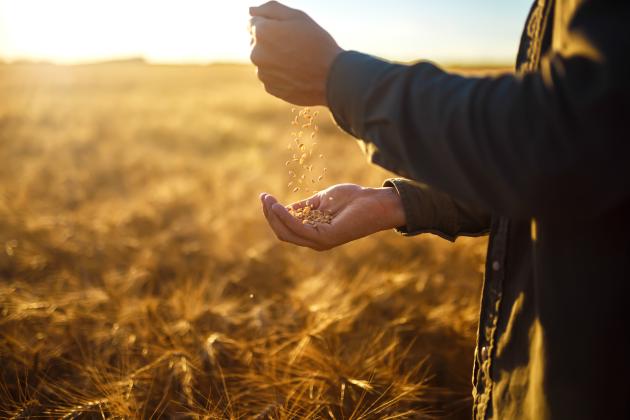Article written by: Robin Reid, K-State Research and Extension Agricultural Economist
Farmers are now entering the last election decision of the 2018 Farm Bill before a new farm bill is developed by September 2023, or an extension of the current farm bill is passed. The decision between Agricultural Risk Coverage (ARC) or Price Loss Coverage (PLC) needs to be made by March 15, 2023, and will be for the crop harvested in 2023, with payment being made (if any) in October of 2024. To give a brief review of these programs, PLC is much like the old countercyclical payment program where payments are made when the Marketing Year Average price (MYA) drops below a certain threshold, called the effective reference price. For corn this is $3.70, soybeans $8.40, wheat $5.50 and grain sorghum $3.95. The difference between the effective reference price and the MYA price is the payment rate, which is multiplied by the established farm yield (PLC yield) with Farm Service Agency (FSA) and then by 85% of the base acres of that commodity. Current commodity prices are much higher than the effective reference prices, so no PLC payments were seen last year and will be unlikely for the coming year.
ARC can be selected either at the county level, which pays 85% of base in the commodity, or individual level, in which all crops on the farm are enrolled and payments are made on 65% of the entire base. ARC-County (ARC-CO) will only be discussed here, as ARC-Individual has had very little use outside of farms that had prevented planting in 2019. ARC-CO is a revenue program, where 5 years of national MYA price and 5 years of county-level yield are used to set a benchmark revenue value, with the guarantee being 86% of that benchmark.
If the current year revenue (national MYA price * actual county yield) falls below the guarantee, payment is made in the amount of the difference, up to 10% of the benchmark revenue. Two downfalls of this program are the 10% cap on payments and the low prices in recent years causing a low guarantee. Historical payments in the ARC-County program are crop and county-specific.
When considering ARC-CO or PLC, the first major point to understand about this decision is when the marketing year actually starts and when the payments (if any) will be received. For fall crops (corn, soybeans, grain sorghum), the marketing year will not start until September 1, 2023, and will run through August 31, 2024. Each month, the national price released by National Agricultural Statistics Service (NASS) will be weighted based on the amount of grain sold in that month, to determine a single national price for the entire 2023/2024 marketing season. Similarly, the wheat-marketing year will start June 1, 2023, and run through May 31, 2024, and payments, if any, will be received in October of 2024. The higher commodity prices that we see now may not necessarily hold for the life of this current decision. The most recent farm program election farmers made was March 15, 2022, which covered the 2022 harvested crops (which we are currently in the marketing year for). When looking at the percentage of commodity base that was elected between ARC-CO and PLC, commodities have been trending more towards ARC-CO because of the higher commodity prices and less likelihood of PLC triggering. Approximately half of the wheat and grain sorghum base selected ARC-CO last year and 64% of corn base. Soybeans have always favored ARC-CO, with over 80% electing that program in Kansas last year.
With ongoing dry conditions, we will likely see more farmers electing ARC-CO again in 2023. While effective reference prices remain the same for 2023, ARC-CO prices are starting to increase. Corn is now $3.98, grain sorghum $4.31, and soybeans $9.57. Wheat remains at $5.50. These prices are still much below the going market rate, so it will take a significant yield loss at the county level to trigger ARC-CO payments. This is entirely possible in areas of western and southeast Kansas, however.
The other factor in the ARC/PLC decision is whether you want to use the Supplemental Coverage Option (SCO) on your crop insurance. SCO provides coverage from your individual crop insurance level up to 86% of your projected revenue. SCO triggers off the county yield however and cannot be used if the base acres of the farm are enrolled in ARC-CO for that commodity. SCO premiums are subsidized at a 65% level, leaving the producer only needing to pay 35% of the premium. While it is county-based coverage and not individual, the subsidy level would lead a person to believe it should pay off in the long run (assuming the product is properly rated). The premiums may still be cost-prohibitive for many farmers, however. If not considering SCO, choosing between ARC-CO and PLC comes down to expectations of price and yield. PLC gives the extreme downside price protection if markets really fall from current prices. ARC-CO will also pay at lower prices but could potentially pay with current prices and a low county yield. Finally, remember that these decisions are made at the farm level, meaning a different decision can be made for each FSA farm number. If one wants to put some base in each program for each crop that can be a good strategy with multiple FSA farm numbers. Farms that have a higher program yield would be the preferred farms for PLC.
For more information, please contact the local K-State Research and Extension Office.
K-State Research and Extension is an equal opportunity provider and employer.

